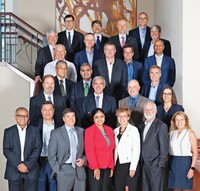Advertisement
Grab your lab coat. Let's get started
Welcome!
Welcome!
Create an account below to get 6 C&EN articles per month, receive newsletters and more - all free.
It seems this is your first time logging in online. Please enter the following information to continue.
As an ACS member you automatically get access to this site. All we need is few more details to create your reading experience.
Not you? Sign in with a different account.
Not you? Sign in with a different account.
ERROR 1
ERROR 1
ERROR 2
ERROR 2
ERROR 2
ERROR 2
ERROR 2
Password and Confirm password must match.
If you have an ACS member number, please enter it here so we can link this account to your membership. (optional)
ERROR 2
ACS values your privacy. By submitting your information, you are gaining access to C&EN and subscribing to our weekly newsletter. We use the information you provide to make your reading experience better, and we will never sell your data to third party members.
Environment
Reaching For The Sun
Chemists convene in Germany to stake out the challenges for solar energy research
by Sarah Everts
August 3, 2009
| A version of this story appeared in
Volume 87, Issue 31

Thirty chemists from China, Germany, Japan, the U.K., and the U.S. met on July 23–25 at a monastery in southern Germany to discuss the current state of solar energy research. They also worked to prioritize scientific challenges that must be met before sunlight can be optimally harnessed as an energy alternative to fossil fuels.
The first meeting, the Chemical Sciences & Society Symposium (CS3), was organized by chemistry associations—including the American Chemical Society, which publishes C&EN—of the five participant countries. Representatives from research funding agencies from those countries, which paid for the conference, also attended.
"Big-time problems—like energy—that involve all of humanity require big-time solutions," says Luis Echegoyen, director of the Chemistry Division for the National Science Foundation, which cosponsored the event. "Chemists have a lot to contribute to solving the energy problem. We wanted to get people together to figure out how to collaborate on an international level" to address the energy challenge.
The goal of the symposium was to pinpoint the "steps required and the direction chemistry research needs to take" to enable solar energy to best contribute to the global energy solution, says Julie Callahan, who works in ACS's Office of International Activities and represented the society at the conference. The three-day event focused on four topics related to solar energy: mimicking photosynthesis using synthetic materials, employing biomass to convert sunlight into usable energy, creating innovative photovoltaics, and storing solar energy in batteries and as fuel.
A conference report aimed at the public, politicians, and policymakers is currently in the works.
"The meeting was an experiment worth trying," says Teruto Ohta, executive director of the Chemical Society of Japan. "These are great challenges, and no country alone knows exactly how to handle them. International cooperation is important."
Organizers hope the conference will be the first of several that tackle "the global challenges of the 21st century and the indispensible role that the chemical sciences play in addressing these issues," says Klaus Müllen, president of the German Chemistry Association.




Join the conversation
Contact the reporter
Submit a Letter to the Editor for publication
Engage with us on Twitter